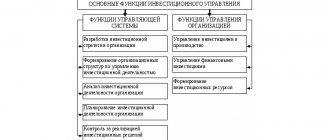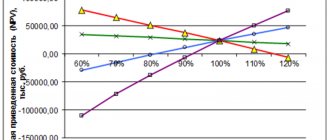Investment project phases
A phase is usually called a certain stage, period, stage of development of any activity, united by similar qualities and characteristics.
The phases of an investment project are those stages that the project goes through in stages: creation, operation and liquidation. It is customary to distinguish several main phases, each of which forms the project life cycle.
An investment project can be called a structure consisting of tasks and processes for achieving them, limited by time periods.
The number, sequence, duration and functional content of project phases depends on:
- technological, legal, financial and other features of the project
- historical practice of implementing similar projects
- interests, wishes and requirements of all participants.
Each phase carries an individual task, and the success of the entire project depends on achieving the objectives at each stage.
Let's consider the two most common classifications that are common to all newly launched investment projects.
The classic life cycle includes the following phases of an investment project :
- pre-investment
- investment
- operational
- elimination phase.
The pre-investment period refers to the phases of implementation of investment projects. Subsequently, the idea is formulated and a concept, implementation plan and feasibility study necessary for investors are developed.
It is worth noting that the authors of the project need to treat this work with full responsibility, because more than half of the success depends on how well the work is done at this stage.
The most significant here is the stage of developing a feasibility study for investments (feasibility study). It is carried out first in a preliminary form, after conducting marketing, financial, and technological research that allows us to identify the prospects and problems of the project, as well as the necessary volumes and sources of financing.
Further, after consultations with potential investors and the expert community, the feasibility study is finalized and takes a completed form agreed upon by all participants.
After the adoption of the roadmap, the financing or investment phase of the project begins. It also applies to the implementation phases.
At this stage, negotiations are underway with contractors, suppliers and other participants. The necessary contracts for the supply of raw materials and supplies and the provision of required services are concluded and signed. In conclusion, the facility is put into operation and is ready to begin the next phase of its life.
The operational phase of an investment project replaces the investment one, but also refers to the period of implementation and development. The production cycle itself takes place here. The most important point is well-functioning control over production, maintaining the required volumes of production and sales.
, the liquidation phase begins . At this stage what happens:
- an analysis of all activities carried out is carried out, the results achieved are assessed, problems and omissions are recorded for their correction in the future
- equipment and production facilities are being sold, liquidated or repurposed
- if there are negative consequences, the owners remove them (environmental, social, etc.)
The longest period in the life cycle is the operational phase. In percentage terms, this is something like 70-80 percent of the total life of the project.
About 5-10 percent is spent on the pre-investment and investment phases, and 5-10 percent is also required for completion and liquidation.
The overall lifespan of a project depends largely on the degree of its profitability, the effectiveness of achieving the set investment goals and the real investment risks. The higher the risks and the lower the level of profitability of the project, the shorter its lifespan, and vice versa. It is worth noting that all risk groups almost equally influence the project at all stages of its life. Success largely depends on minimizing their influence.
The life cycle of modern investment projects follows a slightly different path. The main difference from the classic one is the stage of idea generation.
If in the classic example the reason for implementing the project is one of the ways to develop the business, then in the modern example this motive will be to eliminate one of the problems that impedes the further development of the business.
Based on the above differences, the life cycle will include the following phases:
- problem identification and analysis
- formulating recommendations for its elimination, developing the concept of the idea, setting project objectives
- drawing up a road map of all production, financial, management processes
- implementation or operation stage
- closure/liquidation of the project.
Algorithm of investor actions
Basic rules: investing is a responsible activity.
A novice investor must act in accordance with the following algorithm:
- determine the investment goal;
- learn the basic rules of investment (the basics of wealth);
- analyze your income and expenses and find reserves for saving financial resources;
- determine what percentage of profit will suit you;
- assess the acceptable level of risk;
- draw up a personal realistic financial plan for five years;
- strictly follow the financial plan, periodically making changes to it.
As you can see, the main rules of investing are not at all complicated.
Learning the Basics of Wealth
- save a tenth of all your income;
- Read constantly and improve your financial literacy;
- make it a rule to talk to successful investors once a week;
- try to lend money as little as possible;
- Constantly take various courses on investing, learn what’s new.
Personal financial plan
A personal financial plan for five years should contain the following sections:
Investment Strategies
How to invest correctly? There is nothing complicated in the answer to this question.
You need to invest based on the developed investment strategy, there are only three of them:
- passive;
- active;
- mixed (see Mixed investment strategies).
A passive investment strategy is based on the fact that financial resources are invested in low-risk assets that do not require much time for investment.
These include:
- bank deposits;
- investments in mutual funds;
- buying bonds;
- trust management, etc.
For active investing, the rules are also not very complicated.
Active investments include:
- investments in shares;
- Forex trading;
- other investments in high-risk assets.
The investment rule when using a mixed strategy involves using the first and second strategies in proportions that the investor can determine independently.
Life cycle of an investment project
Purpose of the lecture:
learn to determine the duration of the life cycle of an investment project and divide it into stages.
Life cycle of an investment project
– this is the period of time between the moment the project appears and the moment it is liquidated.
Below we will consider the life cycle
of an investment project using the example of a project for the construction of a manufacturing enterprise. The choice of this example is due to the fact that this type of investment project is the most common. For projects in a different direction, the specific content of the life cycle stages may change, but the essence will remain the same [3].
Stages
life cycle – these are the states that a project goes through in its development. Typically, the project life cycle is divided into three stages:
- Pre-investment stage.
- Investment stage.
- Operational stage.
Pre-investment stage of the life cycle
- this is the period of time between the moment the initial concept of the project appears and the moment the final decision is made on its implementation.
At the pre-investment stage,
one project is selected from several investment options or an investment program is drawn up from several projects (independent or complementary).
The decision to choose an investment option is made based on the comparative effectiveness and riskiness of each project, as well as on available resources. The pre-investment stage of the life cycle
includes the following stages:
- Formation of the initial concept of the project
. Any project begins with the emergence of an idea and the specification of the desired result. - Analysis of investment opportunities for project implementation
. The need for financial resources is assessed, and possible sources for obtaining these resources are considered. - Marketing research (market analysis).
The level of demand for goods or services to be produced by the project is assessed. The target audience (consumers) of the product is determined. Competition in the market of a given industry and region is assessed. - Development of a business plan.
The main purpose of a business plan is to show the attractiveness of the project to a possible investor. - Selecting the location of the enterprise under construction
(if the implementation of the investment project involves construction). - Search for investors.
An investment project can be financed entirely from the investor's own funds or with the involvement of borrowed capital. At the same time, the ratio of equity and borrowed capital in the structure of investment sources may be different. - Allocation of investments for design and survey work.
- Conducting a competition for design and survey work and concluding a contract with the designer.
As a rule, design and survey work is carried out under a contract. The customer announces a competition (tender) in which design organizations can take part. When making a decision, the cost estimate for design and survey work is taken into account, as well as the reputation of the design organization, deadlines for completing the work, etc.
What work is carried out during planning?
At this stage, the following procedures are mandatory:
- market research is carried out;
- possible projects are identified;
- an economic assessment is carried out;
- a variety of options are explored when modeling various constraints (for example, resources or time, while the constraints can be of both a social and economic nature);
- a full-fledged investment portfolio is formed.
You might be interested in:What is portfolio diversification?
Life cycle of an investment project - what is it?
The life cycle of an investment project is the time interval from the idea of the project to its complete liquidation. This is the basic concept for analyzing financing, which allows you to make smart decisions related to the organization, development and completion of the project.
An investment project goes through four successive phases: pre-investment, investment, operational and liquidation. Let's look at each stage in detail.
International investing
International investment is a very interesting area of investment.
Basic rules of international investment:
- "right of entry";
- equal opportunities for investment activities for residents and non-residents;
- right to terminate the contract;
- the right to use transfer prices for direct investment.
Right of entry
This right provides permission for a foreign investor to establish joint ventures or branches of a company. The opportunity to work in the international arena is more interesting for large investors who own businesses on a large scale, allowing them to have a branch network abroad.
Providing a level playing field
Equal conditions for doing business for residents and non-residents are the most important condition for the international investment process.
Typically these conditions include:
- freedom of movement of capital;
- freedom of salary transfers;
- compensation payments in case of non-compliance with the rights of the investor.
Right to terminate the contract
A point that is not entirely convenient for the investor, but important for the receiving party, is related to the right of the receiving country to nationalize its property after paying compensation to the investor. The state should have the right to regulate the influx of investment. Therefore, the right to nationalization is contained in the legislation of almost all countries.
Advice! Before you start investing in another country, you need to carefully study the conditions of nationalization and evaluate their fairness.
Before you start investing, you should study the customs rules for investments. Different countries have their own rules and need to study them.
Investment phase
At the investment phase of the cycle, an investor is often involved in the project, who provides the start of the project with his own financing.
This is the time when the project initiators develop project documentation, enter into contract agreements (choose a construction organization, calculate construction estimates). Then:
- prepare the construction site and begin to build the facility;
- purchase technologies and equipment; deliver, install and prepare equipment for launch;
- recruit personnel and train them to work on site;
- form the capital of the enterprise - fixed and working capital;
- They produce prototypes of the product and gradually bring the enterprise to its designed capacity.
In this phase, the level of costs increases sharply. This phase ends with the commissioning of the facility.
At the same time, marketing activities are carried out to bring the product to the market and build a brand.
Implementation stages
The stages of project implementation certainly include investment, direct implementation of the project, as well as the elimination of any of its consequences. Each of the listed stages involves solving certain problems. Thus, for example, during execution, production and sales are carried out, costs are calculated and the necessary ongoing financing is provided. As you move through the stages and phases of the investment project, the idea of the work is gradually clarified, and new information is added. Thanks to this, we can talk about a kind of intermediate finish at each of these stages. Investors can use the results obtained for further planning of the feasibility of investing money. The start of the next depends on the successful completion of each stage.
Operational phase
Most of the investment life cycle is the operational phase. It accounts for 90-95 percent of all time.
The longer this stage is, the more effective the project is. At that time:
- organize production;
- receive product certificates;
- promote it on the market;
- organize service (if necessary, repairs and warranty service of products);
- manage production taking into account market changes;
- monitor production efficiency;
- determine the moment when consumer interest in the product decreases and find ways to maintain it.
Costs at this stage remain stable.
The final stage of the investment project is liquidation
The liquidation phase is a stage when there is still demand for the product, but the profitability of production is decreasing. Along with it, the weighted average cost of capital of the investee decreases. This suggests that it is time to look for ways to improve efficiency or discontinue production of the product.
The main thing is not to miss the moment of no return, when it is more profitable to close the project than to continue working.
The eradication phase can be fleeting or last several years. Liquidation of production is carried out in two stages:
- The equipment is dismantled and the premises are cleared for a new project.
- They are selling equipment that has become unnecessary. It still has a margin of safety, so small enterprises can buy it for their production.
Each stage of an investment project has its own management features. In the pre-investment and investment phases, the main task is investment management, in the operational phase - capital. At the same time, each stage has its own risks.
At the first stage, these are the risks of shortcomings in the business plan: erroneous forecasts on the level of demand for the product, the discount rate.
In the investment phase , risks associated with the construction of the facility arise: delays in commissioning and reaching design capacity.
During the operation stage , risks are reduced, but technological and financial risks remain.
Dividing the life cycle into phases allows you to determine the duration of the project and highlight a specific list of work at each stage. Understanding the stages of development makes it possible to effectively control an investment project from the moment the idea is conceived until its complete liquidation.
Finding the answer
Total found: 16
| Question No. 293663 |
In the “word check” section on the website, the word “post-Imperial” is suggested to be written through I, and pre-investment and integrand - through Y. What is the difference? What does the Rule sound like, if there is one?
Russian help desk response
The difference is that the prefixes and under. Russians, and the prefix is post. foreign language. The letter ы instead and is written only after Russian prefixes ending in a consonant (except for the prefixes super- and inter-). After foreign language prefixes and persists: hyperinflation, disinformation, disintegration, counter-play, post-impressionism, post-infarction (cf. pre-infarction).
| Question No. 271709 |
Good afternoon Without investment - correct (with “s”)?
Russian help desk response
| Question No. 251077 |
Which is correct: “pre-investment” or “pre-investment”?
Russian help desk response
Correct spelling: pre-investment.
| Question No. 250259 |
Hello! Please tell me how to spell it: pre-Investment or pre-Investment? Thank you!
Russian help desk response
| Question No. 248028 |
Which is correct: pre-investment or pre-investment?
Russian help desk response
| Question No. 244161 |
Hello, how to write correctly: pre-investment research of an enterprise or pre-investment research of an enterprise? Thank you Best regards, Ksenia
Russian help desk response
Correct spelling: pre-investment.
| Question No. 243274 |
pre-investment or pre-investment?
Russian help desk response
That's right: pre-investment.
| Question No. 238565 |
What is the correct spelling: pre-Investment or pre-Investment?
Russian help desk response
| Question No. 238519 |
Hello! For some reason I stopped receiving answers to my questions. Tell me which is correct: pre-investment or pre-investment? And one more question: not to pay attention or not to pay attention?
Russian help desk response
1. Correct with Y. 2. Preferable: ignore.
| Question No. 235022 |
How to write correctly: pre-investment or pre-investment? The rules of the Russian language clearly give the first option, but most published works give the second option. Judge.
Russian help desk response
Correct: _pre-investment_. Writing with I is a mistake (albeit a very common one).
| Question No. 230719 |
Please tell me how to correctly write the word pre-investment? According to the rule, you need to write through Y, but for some reason you want to write through I. Please help. Thank you.
Russian help desk response
Correct spelling through _ы_: _pre-investment_.
| Question No. 226239 |
How to correctly write the word “pre-investment” or “pre-investment”? and why?
Russian help desk response
| Question No. 221926 |
Is it spelled correctly - pre-investment phase or pre-investment phase?
Russian help desk response
| Question No. 208648 |
I found the word “pre-investment” in the news. This is not found in any dictionary; it is probably a new formation. I would like to know how to write it correctly, if it does exist? According to the general rules, it seems that the prefix should be followed by the letter Y. Which is it - “pre-investment” or “pre-investment”? Thank you!
Russian help desk response
| Question No. 205828 |
What is the correct way to write “pre-investment” or “pre-investment”? According to the rules, it seems like through “y” (“backstory”, for example), but in many official documents (RAO UES of Russia, for example) through “and”. Perhaps there are any exceptions? Thank you very much.
Russian help desk response
Correct: _pre-investment_. After the prefix _pre-_ instead of _and_ it is written _ы_.










